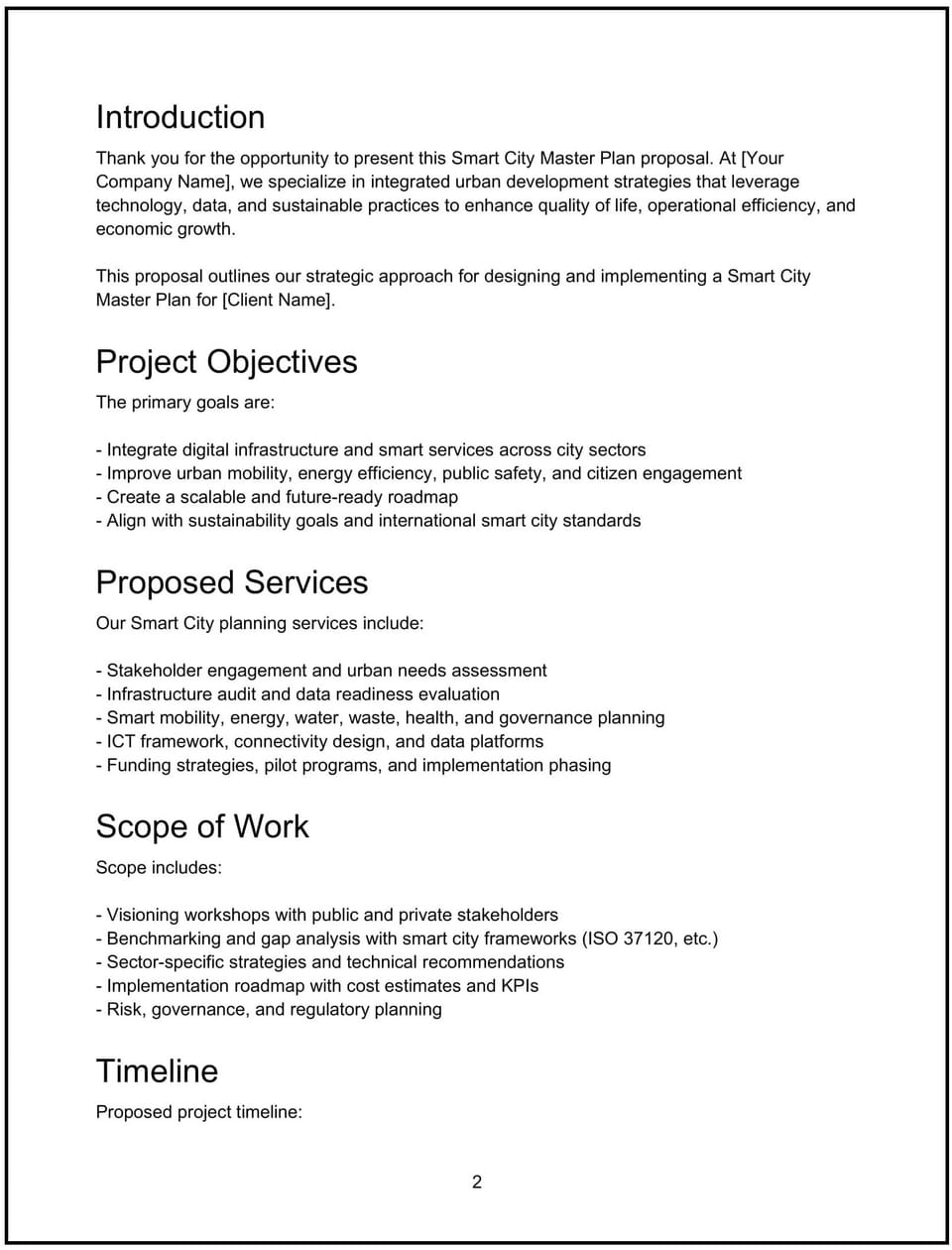Smart city master plan proposal: Free template

Customize this free smart city master plan proposal with Cobrief
Open this free smart city master plan proposal in Cobrief and start editing it instantly using AI. You can adjust the tone, structure, and content based on your offer, the city’s strategic goals, and technological ambitions. You can also use AI to review your draft — spot gaps, tighten language, and improve clarity before sending.
Once you're done, send, download, or save the proposal in one click — no formatting or setup required.
This template is fully customizable and built for real-world use — ideal for pitching comprehensive urban technology strategies, infrastructure modernization, and sustainability initiatives. Whether you’re creating proposals regularly or occasionally, this version gives you a structured head start and removes the guesswork.
What is a smart city master plan proposal?
A smart city master plan proposal outlines a strategic roadmap for integrating technology, data, and sustainable infrastructure to enhance urban living. It details your approach to planning, stakeholder engagement, technology selection, and phased implementation.
Typically shared after initial stakeholder consultations or feasibility studies, this proposal helps align city officials and partners on vision, objectives, scope, timeline, and investment.
A good smart-city master plan proposal helps you:
- Define clear goals for mobility, energy, connectivity, and citizen services.
- Communicate integrated technology and infrastructure strategies.
- Set realistic timelines and milestones for phased deployment.
- Build confidence through stakeholder engagement and risk management.
Use this proposal when you want to present a holistic, actionable plan to modernize urban environments.
Why use Cobrief to edit your proposal
Cobrief makes editing and customizing your proposal efficient with AI assistance:
- Edit fully in-browser — no uploads or formatting hassles.
- Use AI to refine sections for clarity, tone, and professionalism.
- Run AI reviews to identify gaps or unclear language.
- Accept AI suggestions individually or all at once for speed.
- Export or share polished PDFs or DOCX files instantly.
When to use this proposal
This smart city master plan proposal is suitable for:
- Developing city-wide technology and infrastructure modernization programs.
- Planning integrated transportation, energy, and communication networks.
- Creating sustainability and resilience strategies aligned with smart goals.
- Engaging multiple stakeholders — government, private sector, citizens.
- Securing funding or partnerships for large-scale urban projects.
Use this proposal when a comprehensive, collaborative urban strategy is required.
What to include in a smart city master plan proposal
Key sections to communicate your offer clearly:
- Executive summary: Overview of city challenges, vision, and proposed smart-city approach.
- Strategic objectives: Define targets for connectivity, sustainability, safety, and quality of life.
- Technology and infrastructure strategy: Detail planned deployments — IoT, data platforms, green energy, mobility solutions.
- Stakeholder engagement plan: Describe collaboration with public agencies, businesses, and communities.
- Implementation roadmap: Phased plan with milestones, pilot projects, and scalability considerations.
- Budget and funding overview: High-level investment estimates and funding sources.
- Risk management and governance: Outline data privacy, security, and project oversight frameworks.
- Next steps: Clear call to action for approval, workshops, or further planning.
How to write an effective smart city master plan proposal
Write with strategic vision and clarity:
- Lead with urban impact: Emphasize how your plan improves livability, efficiency, and sustainability.
- Balance technical detail with accessibility: Make complex infrastructure understandable to diverse stakeholders.
- Be specific about phases and pilots: Show how gradual implementation manages risk and builds momentum.
- Highlight collaboration: Stress the importance of multi-stakeholder engagement and governance.
- Use data and benchmarks: Reference relevant case studies or metrics to build credibility.
- Close with a clear next step: End with one strong CTA to move the project forward.
Frequently asked questions (FAQs)
How can I tailor this proposal for different city sizes or priorities?
Adjust scope, technology choices, and stakeholder plans based on urban scale and strategic focus.
What’s the best way to present complex technology to non-technical audiences?
Use visuals, simple analogies, and focus on outcomes rather than specs.
How do I handle funding discussions in the proposal?
Provide flexible budgeting ranges and outline potential public/private funding models.
How should I frame governance and privacy concerns?
Highlight frameworks that ensure transparency, citizen trust, and regulatory compliance.
Can I reuse sections for related urban planning proposals?
Yes — modular content can speed up future proposals for infrastructure, sustainability, or mobility plans.
How do I collaborate with stakeholders on proposal revisions?
Use Cobrief’s commenting and version control features to coordinate input and finalize drafts efficiently.
This article contains general legal information and does not contain legal advice. Cobrief is not a law firm or a substitute for an attorney or law firm. The law is complex and changes often. For legal advice, please ask a lawyer.